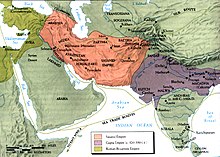This is an old revision of this page, as edited by ImperialAficionado (talk | contribs) at 09:09, 12 December 2023 (Don't do major rv. While the discussion is going on.). The present address (URL) is a permanent link to this revision, which may differ significantly from the current revision.
Revision as of 09:09, 12 December 2023 by ImperialAficionado (talk | contribs) (Don't do major rv. While the discussion is going on.)(diff) ← Previous revision | Latest revision (diff) | Newer revision → (diff)| Chandragupta II's Balkh Campaign | |||||||||
|---|---|---|---|---|---|---|---|---|---|
| Part of Guptas Military Conquests | |||||||||
 Sassanian Empire and Gupta Empire at one time of Conflict | |||||||||
| |||||||||
| Belligerents | |||||||||
| Gupta Empire |
or | ||||||||
| Commanders and leaders | |||||||||
| Chandragupta II | Unknown | ||||||||
The historical account of Chandragupta Vikramaditya, as attributed to the renowned 4th-century CE Sanskrit poet Kalidasa and further elaborated upon in the Brihatkathamanjari by the Kashmiri writer Kshmendra, unveils a compelling narrative of a powerful and ambitious ruler who left an indelible mark on the Indian subcontinent.
Conquest and campaign
The Gupta dynasty's power in the Punjab region is described in an inscription found in the Sacred Rock of Hunza. This ruler is titled "Chandra," and it is believed that he was Chandragupta II. An inscription known as the Meharauli pillar inscription (No.67) is etched on the well-known Iron pillar of Delhi. It includes a king's eulogy who goes by the simple name Chandra. In the Vanga land (Vangeshu), he engaged in combat and vanquished his adversaries who banded together to oppose him. Additionally, he vanquished the Vällikas (Kingdom of Balkh) and and crossed the seven faces or feeders (Sapta Mukhāni) of the river Sindhu in combat. Because of his devotion to Vishnu, the monarch erected a pillar on the hill where Vishnupada stood as a symbol of the God. The expedition was probably directed aganist the Hunas or the Sassanids As a result, Balkh (Bactria) was conquered and the Guptas had won after endless wars with the foreigners of this land.
Aftermath
He returned back from Bactria and was crowned with glory and perhaps laden with riches.
Thereafter, the King proceeded into the Himalaya mountains to reduce the mountain tribes of the Kinnaras, Kiratas, as well as India proper.
References
- ^ Others, Muzaffar H. Syed & (2022-02-20). History of Indian Nation : Ancient India. K.K. Publications. p. 125.
- ^ Agrawal, Ashvini (1989). Rise and Fall of the Imperial Guptas. Motilal Banarsidass Publ. p. 165. ISBN 978-81-208-0592-7.
- ^ Fodor, Eugene; Curtis, William (1975). Fodor's Islamic Asia: Iran, Afghanistan, Pakistan. Hodder and Stoughton. ISBN 978-0-340-19191-0.
- ^ Brown, W. Norman (2016-11-11). India, Pakistan, Ceylon. University of Pennsylvania Press. p. 122. ISBN 978-1-5128-1486-6.
- Sharma, Tej Ram (1989). A Political History of Imperial Guptas. Concept Publishing Company. p. 157.
- Majumdar, R.C. (1981). A Comprehensive History of India Vol. III, Part 1 (A.D. 300-985). People's Publ. House,New Delhi. p. 55.
- Roy, Kuashik (2015). Warfare in Pre-British India. Taylor & Francis. p. 57.
The expedition was directed probably against the Huns or the Sassanids.